#51: Peter Gunn by Art of Noise
City: Hamilton, ON
Radio Station: CKOC
Peak Month: July 1986
Peak Position in Hamilton ~ #2
Peak position in Vancouver ~ #22
Peak Position on Billboard Hot 100 ~ #50
YouTube: “Peter Gunn”
Gary Michael Langan was born in 1956 in Surrey, England. When he turned 18, he began working as an assistant engineer at Sarm East Studios in London. He worked on Queen’s albums A Night At the Opera (1975), A Day At the Races (1976), and News of the World (1977), Yes’s album 90125 (1983), and ABC’s Beauty Stab (1982), and later 1234 for Propaganda. Some of the hit singles he engineered include “Bohemian Rhapsody”, “You’re My Best Friend” and “We Are The Champions” for Queen, “Video Killed The Radio Star” for The Buggles, “Poison Arrow” and “The Look of Love” for ABC, “Owner Of a Lonely Heart” for Yes, and “Double Dutch” for Malcolm McLaren. In 1983 he co-founded The Art of Noise.
Jonathan Edward Stephen “J. J.” Jeczalik was born in Banbury, England, in 1955. He began his journey into music after coming to London and promoting a gig for a pub group called Landscape (of the 1979 UK top ten hit “Einstein A Go-Go”), then later roadied for their co-lead singer Richard James Burgess before meeting the Buggles a.k.a. Trevor Horn and Geoff Downes. Jeczalik became a freelance programmer. When he was working on the Yes album 90125, he met Gary Langan. Together, they created a tune titled “Beat Box”. During production on a Malcolm McLaren album in 1983, Langan and Jeczalik met Anne Dudley. She was born in Beckenham, Kent, England, in 1956. Her birth name was Anne Beckingham (an almost identical surname to the town she was born in). She graduated with a master’s in music from King’s College London in 1978. Trained as a classical performer, she moved into the competitive commercial field as a session musician, where her professional relationship with Trevor Horn began.
In 1983, as The Art of Noise was forming – without a name at this point – Langan, Jeczalik and Dudley asked Trevor Horn to join them. In turn Horn invited music journalist, Paul Morley, to help work on concepts. He came up with the name for the group. Morley told the Guardian, “I loved the name Art of Noise so much that I forced my way into the group. If over the years people asked me what I did in the group, I replied that I named them, and it was such a great name, that was enough to justify my role. I was the Ringo Starr of Art of Noise. I made the tea. Oh, and I wrote the lyrics to one of the loveliest pieces of pop music ever, Moments in Love.” Morley also reveals, “The Art of Noises was a 1913 manifesto about musical aesthetics, we performed an edit and named the group the Art of Noise.”
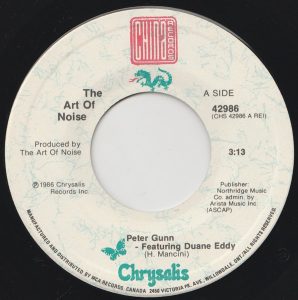
“Peter Gunn” is an instrumental written by Henri Mancini. Enrico Nicola Mancini was born in Maple Heights, Ohio, in 1924. Both his parents were Italian immigrants to the USA. At age eight Enrico learned to play the piccolo. He later studied at the Juilliard School of Music. When he turned 18 he enlisted in the United States Army he met Glenn Miller at basic training. Owing to a recommendation by Miller, Mancini was first assigned to the 28th Air Force Band before being reassigned overseas to the 1306th Engineers Brigade in France. In 1945, he helped liberate the Mauthausen-Gusen concentration camp in Austria. In 1946, he became a pianist and arranger for the newly re-formed Glenn Miller Orchestra, led by ‘Everyman’ Tex Beneke. (Glenn Miller was declared missing in action after his plane disappeared over the English Channel in December 1944). In 1952, Henry Mancini joined Universal Studios’ Universal-International music department. In 1952 he scored music for The Raiders, and in 1953 for The Glenn Miller Story.
These were the first few of a hundred films Mancini scored music for. Notable among these films are The Benny Goodman Story, Mr. Hobbs Takes A Vacation, Charade, The Great Race, The Molly Maguires, That’s Entertainment, The Return of the Pink Panther, The Return of the Pink Panther, The Pink Panther Strikes Again, The Prisoner of Zenda, That’s Dancing and many more. In 1958, Mancini left Universal to become an independent composer/arranger.
In 1959, Henry Mancini won two Grammy Awards for The Music from Peter Gunn. The first was for Album of the Year and the second was for Best Arrangement. However, it was Ray Anthony’s instrumental cover of “Peter Gunn” that was a top selling single, peaking at #8 on the Billboard Hot 100.
In 1961, Mancini won two Academy Awards, one for “Moon River” for Best Original Song and one for Best Scoring of a Dramatic or Comedy Picture for the movie Breakfast at Tiffany’s. Mancini’s instrumental “Moon River” climbed to #11 on the Billboard Hot 100. In 1962, he won Best Original Song again, this time for “Days of Wine and Roses”. He won Best Original Score again in 1982 for the movie Victor/Victoria.
Over the decades, Mancini was nominated for 72 Grammy Awards and won 20. He was nominated for 18 Academy Awards and won four. He also won a Golden Globe Award and was nominated for two Emmy Awards. Over the years, Mancini also composed and scored music for many TV shows, including Newhart, Remington Steele, Tic Tac Dough, and Hotel. In 1994, Henry Mancini died of pancreatic cancer at the age of 70.
Peter Gunn is a TV show that began airing on NBC in 1958, and switched to ABC for its final season in 1960-61. Peter Gunn is a suave, well-dressed private investigator whose hair is always in place and who loves cool jazz. Whereas other gumshoes are often coarse and vulgar, Gunn is a sophisticate with expensive tastes. A contemporary article in Life noted that Edwards “deliberately tailored the part after the famous movie smoothie Cary Grant.” He wears $30 shoes ($325 in 2024 dollars) and a $200 suit ($2,165 in 2024). He also drives a two-door two-tone DeSoto in the first season, and in season two drives a Plymouth Fury.
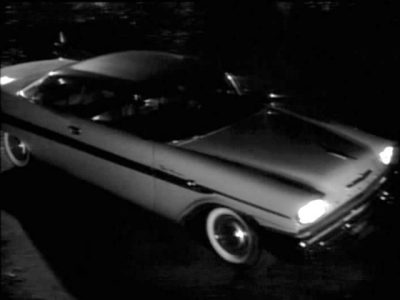
1958 DeSoto Firelite Sportsman two-door Coupe in Peter Gunn
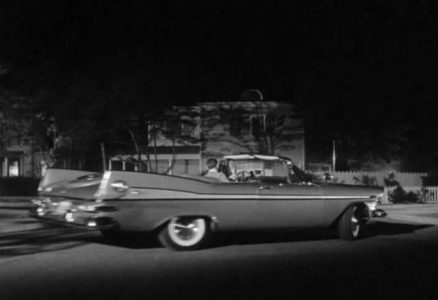
1959 Plymouth Fury in Peter Gunn
Craig Stevens played Peter Gunn, and his girlfriend was Edie Hart (Lola Albright), a jazz lounge singer.
Gunn operates in a gloomy waterfront city, the name and location of which is not revealed in the series. He often visits Mother’s, a smokey, wharfside jazz club that Gunn uses as his “office”, usually meeting new clients there. Gunn has a reputation for integrity and being among the best investigators; he has many reliable informants and is well-connected. His reputation is so good, the police occasionally ask him for help or advice. He sometimes works cases out of state and occasionally out of the country.
In 1960, Duane Eddy released a version of “Peter Gunn” which climbed to #6 in the UK and #27 on the Billboard Hot 100. In Canada, Duane Eddy’s version peaked at #1 in Calgary and Winnipeg, each for three weeks, #6 in Vancouver, and #7 in Regina.
In 1965, Henri Mancini released a variant of “Peter Gunn” titled “Señor Peter Gunn” on his 1965 album, The Latin Sound of Henry Mancini. In 1967, a film based on the TV series titled Gunn starred Craig Stevens.
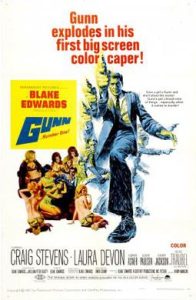
Henri Mancini was commissioned to compose the score for the film, which included a theme tune titled “Gunn…Number One!”.
In 1989, a 90-minute pilot TV special, Peter Gunn, aired on ABC. Despite good ratings, the network failed to capitalize on the interest and a TV series was never commissioned.
The Art of Noise teamed up with Duane Eddy to record “Peter Gunn” Duane Eddy was born in Corning, New York, in 1938. When he turned five years old he started to play guitar. His family moved to Arizona and in 1954, at the age of 16, Eddy got a Chet Atkins Gretch guitar. In 1954, at Coolidge High School Duane met Jimmy Delbridge who shared his love of music. Both boys played guitar and sang. In short order they were appearing on local radio in Coolidge, KCKY, as Jimmy and Duane. Jimmy sang best and Duane was a superior guitar player. Duane persuaded Jimmy leave the guitar behind and play piano. During 1955 local Phoenix disc jockey Lee Hazlewood was informally managing the duo. In June ’55 Hazlewood drove Eddy and Jimmy Dell (as he was now known) to Ramsey Recording Studio in Phoenix. In the studio the duo recorded the first of Hazelwood’s songs, “Soda Fountain Girl” and “I Want Some Lovin’ Baby”. These were old hillbilly tunes backed by Buddy Long & the Western Melody Boys.
Eddy released his first album, Have ‘Twangy’ Guitar Will Travel on January 9, 1958. He had a Top Ten instrumental hit that year with “Rebel Rouser”. He returned to the Top Ten in the summer of ’59 when “Forty Miles Of Bad Road” peaked at #9 on the Hot 100. While in 1960 “Because They’re Young” climbed to #4 on the Billboard Hot 100.
“Peter Gunn” peaked at #2 in Hamilton (ON), #4 in San Francisco, #7 in Toronto, #9 in Ottawa, #10 in Boston and Buffalo, and #12 in Montreal.
Gary Langan went on to engineer “Flesh For Fantasy” and “White Wedding” for Billy Idol, and “You Make Me Feel Mighty Real” for Jimmy Somerville, and many more.
Anne Dudley went on to produce Buster: The Original Motion Picture Soundtrack (1988), The Crying Game: Original Motion Picture Soundtrack (1992), the musical score for Tristan & Isolde (2006), and over a dozen other scores for film. Dudley has been a session musician and arranger for recordings by Elton John, Propaganda, a-ha, Rick Astley, Cher, Lloyd Cole and the Commotions, Frankie Goes to Hollywood’s “Two Tribes” and “Welcome To The Pleasuredome”, Annie Lennox’s “No More I Love You’s”, Paul McCartney, Lisa Minelli, George Michael’s “Careless Whisper”, OMD, Pet Shop Boys “Go West”, Seal, Rod Stewart, Tina Turner, Wet Wet Wet, Wham!’s “Everything She Wants”, and many more.
June 26, 2024
Ray McGinnis
References:
John Caps, Henry Mancini: Reinventing Film Music, (University of Illinois, 2012).
Richard Severo, “Henry Mancini dies at 70, Composer for films and TV,” New York Times, June 15, 1994.
“Berklee honors late Henry Mancini,” Associated Press, May 12, 1997.
Duane Eddy bio, History of Rock.com.
“Review: Duane Eddy, Bridgewater Hall, Manchester,” The Argus, Brighton, UK, October 31, 2018.
Gunn, Paramount Pictures, 1967.
Andy Jones, “Who’s Afraid of the Art of Noise?,” Classicpopmag.com, February 21, 2024.
Imogen Tilden, “How we made Art of Noise’s Close (to the Edit),” Guardian, July 3, 2018.
Richard Cromelin, “Duane Eddy Rocks Life into the Art of Noise,” Los Angeles Times, July 31, 1986.
“J.J. Jeczalik,” theartofnoiseonline.com.
“Anne Dudley,” theartofnoiseonline.com.
“Gary Langan,” theartofnoiseonline.com.
“Paul Morley,” theartofnoiseonline.com.
Nenri Mancini, “Senor Peter Gunn,” RCA Victor, 1965.
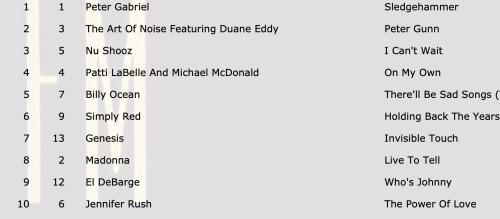
CKOC 1150-AM Hamilton (ON) Top Ten | July 2, 1986

Loved watching Peter Gunn in the late 50s/early 60s starring Craig Stevens. The theme song was great. And a good song/instrumental passes the test of time. Kudos to Art of Noise for their arrangement.
Thanks Tom!